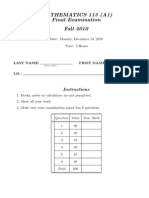Derivadas 7
Uploaded by
Oscar Boris Tello SamillanDerivadas 7
Uploaded by
Oscar Boris Tello Samillan1.
Given that f(x) = (2x + 5)3 find (a) (b) f (x);
f ( x)dx.
Working:
Answers: (a) .. (b) ......................................................... .........
(Total 4 marks)
2.
Given that
3
g ( x ) dx
1
= 10, deduce the value of
(a)
2 g ( x)dx;
1
(b)
( g ( x) + 4)dx.
1
Working:
Answers: (a)
1
.. (b) ......................................................... .........
(Total 6 marks)
3.
Let f(x) = (3x + 4)5. Find (a) (b) f(x);
f(x)dx.
Working:
Answers: (a) .. (b) ......................................................... .........
(Total 6 marks)
4.
The function g(x) is defined for 3 x 3. The behaviour of g(x) and g(x) is given in the tables below. x 3 < x < 2 g(x) negati v e 0 2 2 < x < 1 positiv e 0 negati v e 1 1<x < 3
3 < x < 1 2
1 2
1 2<x< 3
g(x)
positive
negative
Use the information above to answer the following. In each case, justify your answer. (a) (b) (c) (d) Write down the value of x for which g has a maximum.
(2)
On which intervals is the value of g decreasing?
(2)
Write down the value of x for which the graph of g has a point of inflexion.
(2)
Given that g(3) = 1, sketch the graph of g. On the sketch, clearly indicate the position of the maximum point, the minimum point, and the point of inflexion.
(3) (Total 9 marks)
5.
The function f is given by
f ( x) =1
(a) (i) (ii)
2x 1+ x 2
To display the graph of y = f(x) for 10 x 10, a suitable interval for y, a y b must be chosen. Suggest appropriate values for a and b . Give the equation of the asymptote of the graph.
(3)
f ( x) =
2x 2 2 (1 + x 2 ) 2
.
(4)
(b) (c) (d)
Show that
Use your answer to part (b) to find the coordinates of the maximum point of the graph.
(3)
(i)
Either by inspection or by using an appropriate substitution, find
f ( x) dx
(ii) Hence find the exact area of the region enclosed by the graph of f, the x-axis and the y-axis.
(8) (Total 18 marks)
You might also like
- MATH 2413 Calculus I Prerequisite ReviewNo ratings yetMATH 2413 Calculus I Prerequisite Review6 pages
- IB Questionbank Mathematics Higher Level 3rd Edition 1No ratings yetIB Questionbank Mathematics Higher Level 3rd Edition 16 pages
- 3 Revision Paper - Functions and Graphs CIE Math IGCSE Extended 0850No ratings yet3 Revision Paper - Functions and Graphs CIE Math IGCSE Extended 085037 pages
- Differentiate With Respect To X (A) (B) E: Working: AnswersNo ratings yetDifferentiate With Respect To X (A) (B) E: Working: Answers18 pages
- Trigonometry & Calculus Past Paper QuestionsNo ratings yetTrigonometry & Calculus Past Paper Questions6 pages
- Mathematics 113 (A1) Final Examination Fall 2010: InstructionsNo ratings yetMathematics 113 (A1) Final Examination Fall 2010: Instructions4 pages
- Book 4 Chapter 4 Extra Exercise - QuestionsNo ratings yetBook 4 Chapter 4 Extra Exercise - Questions4 pages
- Week 4 Composition of Functions Inverse of FunctionsNo ratings yetWeek 4 Composition of Functions Inverse of Functions6 pages
- IB Math SL 2 - Integration Worksheet Name - 1No ratings yetIB Math SL 2 - Integration Worksheet Name - 12 pages
- Section A-Very Short Answers (1M 20) : Compiled by:ULKA SHAH No. 97240 64249No ratings yetSection A-Very Short Answers (1M 20) : Compiled by:ULKA SHAH No. 97240 642494 pages
- Confucius Tuition Centre YEAR 2016 Test 1: Additional Mathematics Form 4 Time: 1 HOURNo ratings yetConfucius Tuition Centre YEAR 2016 Test 1: Additional Mathematics Form 4 Time: 1 HOUR13 pages
- Core Mathematics C3: GCE Examinations Advanced SubsidiaryNo ratings yetCore Mathematics C3: GCE Examinations Advanced Subsidiary4 pages
- Math 1151 Practice Problems For Final Exam Spring 2024No ratings yetMath 1151 Practice Problems For Final Exam Spring 20247 pages
- Math 1151 Practice Problems For Final Exam Spring 20240% (1)Math 1151 Practice Problems For Final Exam Spring 20247 pages
- functions-graphing-transformation-of-graphs-sets-probability-shading-inequalities-homework-assignmentNo ratings yetfunctions-graphing-transformation-of-graphs-sets-probability-shading-inequalities-homework-assignment18 pages
- Algebra of Functions Composition SymmetryNo ratings yetAlgebra of Functions Composition Symmetry9 pages



























































